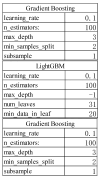Machine Learning-Based Prediction of Feed Conversion Ratio: A Feasibility Study of Using Short-Term FCR Data for Long-Term Feed Conversion Ratio (FCR) Prediction
- PMID: 40564324
- PMCID: PMC12189232
- DOI: 10.3390/ani15121773
Machine Learning-Based Prediction of Feed Conversion Ratio: A Feasibility Study of Using Short-Term FCR Data for Long-Term Feed Conversion Ratio (FCR) Prediction
Abstract
Feed conversion ratio (FCR) is a critical indicator of production efficiency in livestock husbandry. Improving FCR is essential for optimizing resource utilization and enhancing productivity. Traditional methods for FCR optimization rely on experience and long-term data collection, which are time-consuming and inefficient. This study explores the feasibility of predicting long-term FCR using short-term FCR data based on machine learning techniques. We employed nineteen machine learning algorithms, including Linear Regression, support vector machines (SVMs), and Gradient Boosting, using historical datasets to train and validate the models. The results show that the Gradient Boosting model demonstrated superior performance, achieving a coefficient of determination (R2) of 0.72 and a correlation of 0.85 between predicted and actual values when the testing interval exceeded 40 kg. Therefore, we recommend a minimum feeding measurement interval of 40 kg. Furthermore, when the testing interval was set to 40 kg and further refined to the range of 50-90 kg, the model achieved an R2 of 0.81 and a correlation of 0.90 for FCR prediction in the 30-105 kg range. Among the 19 machine learning algorithms tested, Gradient Boosting, LightGBM, and CatBoost showed superior performance, with Gradient Boosting achieving the best results. Considering practical production requirements, the 50-90 kg feeding stage proved to be the most ideal for FCR testing. This study provides a more effective method for predicting feed efficiency and offers robust data support for precision livestock farming.
Keywords: data prediction; deep learning; feed conversion ratio (FCR); machine learning; precision livestock farming.
Conflict of interest statement
The authors declare no conflicts of interest.
Figures
Similar articles
-
Interventions for preventing weight gain after smoking cessation.Cochrane Database Syst Rev. 2012 Jan 18;1:CD006219. doi: 10.1002/14651858.CD006219.pub3. Cochrane Database Syst Rev. 2012. Update in: Cochrane Database Syst Rev. 2021 Oct 6;10:CD006219. doi: 10.1002/14651858.CD006219.pub4. PMID: 22258966 Updated.
-
A meta-analysis of genome-wide association studies to identify candidate genes associated with feed efficiency traits in pigs.J Anim Sci. 2025 Jan 4;103:skaf010. doi: 10.1093/jas/skaf010. J Anim Sci. 2025. PMID: 39847436 Free PMC article.
-
Sertindole for schizophrenia.Cochrane Database Syst Rev. 2005 Jul 20;2005(3):CD001715. doi: 10.1002/14651858.CD001715.pub2. Cochrane Database Syst Rev. 2005. PMID: 16034864 Free PMC article.
-
Predicting cognitive decline: Deep-learning reveals subtle brain changes in pre-MCI stage.J Prev Alzheimers Dis. 2025 May;12(5):100079. doi: 10.1016/j.tjpad.2025.100079. Epub 2025 Feb 6. J Prev Alzheimers Dis. 2025. PMID: 39920001 Free PMC article.
-
Corticosteroids for the treatment of Duchenne muscular dystrophy.Cochrane Database Syst Rev. 2016 May 5;2016(5):CD003725. doi: 10.1002/14651858.CD003725.pub4. Cochrane Database Syst Rev. 2016. PMID: 27149418 Free PMC article.
References
-
- Petrović B., Bumbálek R., Zoubek T., Kuneš R., Smutný L., Bartoš P. Application of precision agriculture technologies in Central Europe-review. J. Agric. Food Res. 2024;15:101048. doi: 10.1016/j.jafr.2024.101048. - DOI
-
- Yamsani N., Muthukumaran K., Kumar B.S., Asha V., Singh N., Dhanraj J. IoT-Based Livestock Monitoring and Management System Using Machine Learning Algorithms; Proceedings of the 2024 International Conference on Science Technology Engineering and Management (ICSTEM); Putrajaya, Malaysia. 19–20 December 2024; pp. 1–6.
-
- Prakash A., Saxena V.K., Singh M.K. Genetic analysis of residual feed intake, feed conversion ratio and related growth parameters in broiler chicken: A review. World’s Poult. Sci. J. 2020;76:304–317. doi: 10.1080/00439339.2020.1735978. - DOI
-
- France J., Theodorou M., Lowman R., Beever D.J.F.S. Feed evaluation models. In: Theodorou M., France J., editors. Feed Evaluation for Animal Production. CAB International; Oxfordshire, UK: 2000. pp. 1–9.
Grants and funding
- 2023ZD04045/STI 2030-Major Projects
- 2021ZDZX0008, 2021YFYZ0030/Sichuan Science and Technology Program
- CARS-35/China Agriculture Research System
- SCCXTD-2024-8/he Program for Pig Industry Technology System Innovation Team of Sichuan Province
- NCTIP-XD/C13/National Center of Technology Innovation for Pigs
LinkOut - more resources
Full Text Sources





